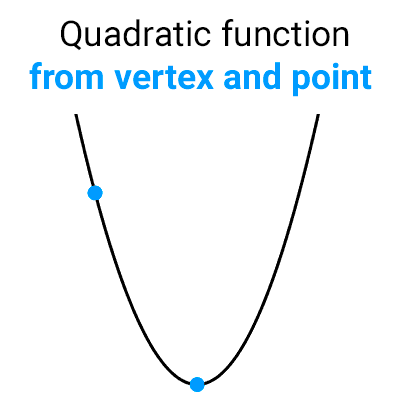
How to write a quadratic function in Vertex Form
In this article we explain how to find the vertex form of a quadratic function with complete step-by-step examples.
Table of Contents
What is the vertex form?
The vertex form (also called standard form) of a quadratic function *f(x)=ax^2+bx+c* with vertex *V(h,k)* is:
*f(x)=a(x-h)^2+k*
For example, the following quadratic functions are written in their vertex form:
*f(x)=2(x-3)^2+5*
*g(x)=-4(x+1)^2*
*h(x)=(x-2)^2-1*
How to find the vertex form
To find the vertex form, we can first calculate the coordinates of the vertex and substitute them into the formula *f(x)=a(x-h)^2+k.* Another way to arrive at it is from the polynomial form using the process called completing the square, where we modify the expression until it takes the form we need.
We start with the polynomial equation:
*f(x)=ax^2+bx+c*
Factor out *a:*
*f(x)-c=a\left(x^2+\dfrac{bx}{a}\right)*
*f(x)-c=a\left(x^2+\dfrac{bx}{a}{\color{red}+\dfrac{b^2}{4a^2}-\dfrac{b^2}{4a^2}}\right)*
Note that the sum of the numbers in red is zero, but its introduction allows constructing a square binomial because *\dfrac{b^2}{4a^2}=\left(\dfrac{b}{2a}\right)^2*
*f(x)-c=a\left[\left(x+\dfrac{b}{2a}\right)^2-\dfrac{b^2}{4a^2}\right]*
(You can perform the operations to confirm that the expressions are equivalent).
*f(x)=a\left(x+\dfrac{b}{2a}\right)^2-\dfrac{b^2}{4a}+c*
*f(x)=a\left(x+\dfrac{b}{2a}\right)^2+\dfrac{4ac-b^2}{4a}*
It can be verified that this expression is nothing but *f(x)=a(x-h)^2+k* where the vertex has coordinates *V(h,k):*
*h=\dfrac{-b}{2a}*
*k=\dfrac{4ac-b^2}{4a}*
This process has been done with the general equation, but for each particular case, we could resort to completing the square to find its vertex expression.
Procedure to find the vertex form of a quadratic function
- Factor out the leading coefficient a.
- Divide the term bx by 2x and square to get the number that completes the perfect square trinomial.
- Add and subtract the above number to the expression of the function.
- Write the square binomial, which will have the square root of the leading term added to the term bx divided by 2x.
- Distribute the number a and perform the necessary operations.
- The obtained expression is the vertex form of the function.
Solved exercises
Exercise 1: Write the function *f(x)=2x^2-8x-7* in its vertex form.
Solution:
Move *7* to the other side to simplify the calculation:
*f(x)+7=2x^2-8x*
Factor out *2*:
*f(x)+7=2(x^2-4x)*
Divide the term *-4x* by *2x* and square it:
This number completes the perfect square trinomial, and we can express it as:
*f(x)+7=2({\color{blue}x^2-4x+4}-4)*
*f(x)+7=2[{\color{blue}(x-2)^2}-4]*
*f(x)=2(x-2)^2-8-7*
*f(x)=2(x-2)^2-15*
This is the vertex form of the function.
Exercise 2: Find the vertex form of the function *f(x)=x^2+8x*
Solution:
As there is no *c* term, and *a* is equal to 1, we can take a more direct path.
Divide the term *8x* by *2x* and square it to get the term that completes the trinomial:
*\left(\dfrac{8x}{2x}\right)^2=16*
*f(x)=x^2+8x+16-16*
Remember to add and subtract the term 16 so that it does not alter the value of the expression (we are adding zero).
Now, write the square binomial that arises from extracting the square root of the first term plus the second term divided by *2x:*
*f(x)=(x+4)^2-16*
This is the vertex form of the function.
Exercise 3: Find the vertex form of the function *f(x)=-4x^2+8x+20*
Solution:
Factor out *a=-4:*
*f(x)-20=-4(x^2+2x)*
Divide the term *2x* by *2x* and square it:
*\left(\dfrac{2x}{2x}\right)^2=1*
Add and subtract this number to the expression:
*f(x)-20=-4(x^2+2x+1-1)*
Write the square binomial by extracting the square root of the first term and adding the second term divided by *2x:*
*f(x)-20=-4[(x+1)^2-1]*
Distribute the number *-4* and perform the necessary operations:
*f(x)=-4(x+1)^2+4+20*
*f(x)=-4(x+1)^2+24*
This is the vertex form of the original function.





Other articles that may interest you